Plastic usage and recycling in the UK – now and in the future
We all know and accept that plastic, while having extraordinary uses, isn’t always ideal for the environment. The environmentally conscious among us also know we should all do more to avoid single-use plastics, reduce plastic consumption, and recycle as much plastic as possible. While some may try to avoid plastic altogether, it does have its uses in society and will likely continue to play a part in our daily lives for generations to come.
What are the pros of plastic?
Plastic has revolutionised the way we make and consume just about everything. From making medical equipment safer to prolonging the shelf life of food, here are some of the perks of plastic that make it pretty fantastic.
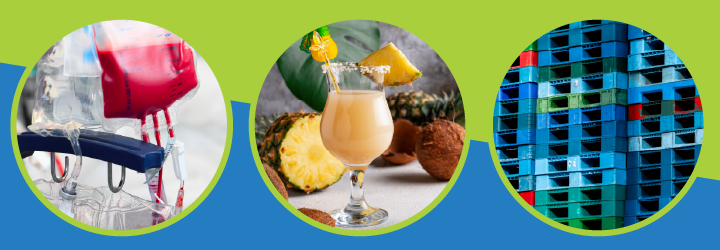
Plastic usage in medical settings
Using plastic in healthcare is essential. Think of something as simple as an IV bag. These were once made of glass. While glass is reusable, it is expensive to produce and prone to breaking. Plastic, in contrast, is cheap to make and transport (due to its lightweight nature), and being single-use reduces the risk of infection. The same applies to many other types of medical equipment. Syringes, catheters, blister packaging, inhalers, and insulin pens are all medical items typically made from plastic. Using plastic for these items improves safety (no one wants a glass catheter to shatter!), reduces the likelihood of infections, prolongs the shelf life of medicine, and lowers costs for national health services.
Plastic reduces food waste by prolonging shelf life
Plastic prolongs the shelf life of many types of food and drink packaging by creating a barrier against moisture, oxygen, and contaminants – all of which can cause perishables to spoil. It can also protect products from physical damage. From shrink-wrapping cucumbers to preventing crisps from going stale, plastic packaging is used to prolong the shelf life of all sorts of products, thereby reducing waste.
The fact of the matter is, most of us enjoy food and drinks that are grown or prepared outside of our local radius. If you’ve treated yourself to a piña colada at your local watering hole, tucked into an exotic takeaway, or packed a little chocolate bar treat into your child’s lunchbox, you will have benefited from the convenience of plastic packaging. Whether plastic is used to preserve food in the armed forces’ rations, in your eccentric neighbour’s nuclear apocalypse bunker, or simply in your fridge or kitchen cupboards, it serves a much-needed purpose.

Plastic is light, reducing transport costs when shipping goods
Using plastic in logistics has some big advantages. Plastic is lightweight, meaning reduced fuel consumption and, in turn, carbon emissions for fleet operators. It is also durable, reusable, easy to clean, and requires much less maintenance than something like wooden pallets when transporting large loads of products or materials. However, some may argue that, because plastic is made from petrol (refined crude oil), the well-to-tank fuel saving is negated. For instance, some sources say that manufacturing a single plastic bottle would require around ⅙ of the bottle’s capacity in oil. The UK government suggests that 1 tonne of polyethylene (the material most plastic bottles are made from) requires 2 tonnes of oil to produce.
Of course, every coin has two sides.
What are the cons of plastic?
There are many downsides to such widespread plastic usage in the name of convenience. The humble milkman, for instance, has largely disappeared. The whirr of slow but steady milk floats and the magic of milk bottles appearing overnight on the doorstep were once an invigorating part of life for many UK households. In the 1970s, 94% of Britons had their milk delivered in glass bottles via an electric milk float. By 2016, that number had dwindled to just 3%! Aside from the disappearance of the milkman – or woman – there are many colossal downsides to plastic usage that are felt across the globe.
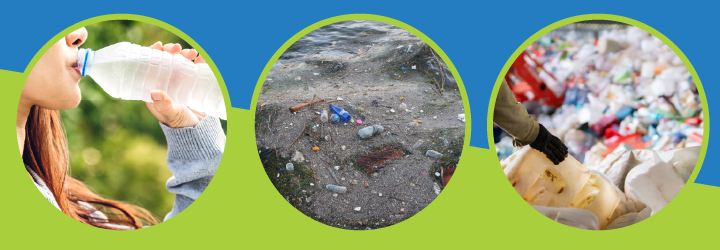
Microplastics on the mind
When plastics “break down”, they degrade into smaller plastic fragments – microplastics and nanoplastics – and they’re everywhere. From the depths of the Mariana Trench to the top of Mount Everest, microplastics have crept into our ecosystems and even our brains. The volume of microplastics in the brain also appears to be increasing over time, rising by around 50% between 2016 and 2024. Today, your brain could contain a whole spoon’s worth of microplastics. But why exactly is this a problem?
Growing evidence suggests that microplastic exposure is harmful to all life. It has made fish and birds more vulnerable to infections. It causes biological changes in animals, including inflammation, altered metabolic function, immune system impairment, and abnormal organ development. Worryingly, it is also suspected that microplastic accumulation may be linked to elevated cancer risk.
Synthetics in our seas
In marine environments, microplastics also cause havoc. For one, fish and other aquatic creatures often mistake microplastics for food. Professor Richard Thompson OBE FRS, the man who coined the term microplastics, said that:
“After 20 years of research, there is clear evidence of harmful effects from microplastic pollution on a global scale”
“There are still unknowns, but during the 20 years since our first study, the amount of plastic in our oceans has increased by around 50%, only further emphasising the pressing need for action”.
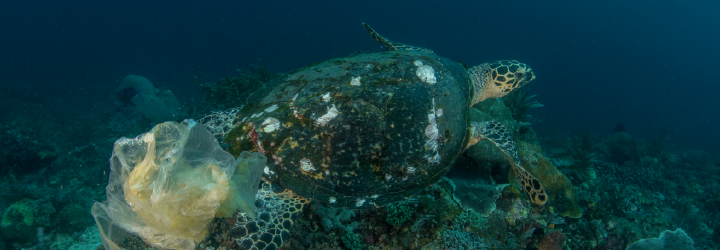
In one of Professor Richard Thompson’s studies, he demonstrated the first evidence that sea creatures ingest microplastic particles and that, when the particles are ingested, they accumulate. These, in turn, are then ingested further up the food chain. A recent study found microplastics in 99% of seafood samples, including salmon, lingcod, herring, and shrimp.
As well as being a menace in the food chain, some plastics are also changing the sex of our fish.
Phthalates, a group of synthetic chemicals that are used to make plastics more flexible, have also been found to disrupt the endocrine system – ie the system that creates and releases hormones. When plastics that contain phthalates enter water sources, they can affect entire ecosystems. A fifth of male fish in UK rivers are now ‘trans-gender’ or ‘intersex’ as a result of hormone-altering chemicals like phthalates. The Environment Agency stated in a recent report that “this phenomenon could potentially have chronic impacts on the sustainability of fish populations”.

As guardians of the earth, only humankind can make the changes needed to protect these ecosystems and prevent further damage to the natural world, at sea and on land.
Plastic exports from the UK
The plastic industry itself is also rife with its own dangers, particularly for plastic sent overseas.
Waste is one of the UK’s largest exports. While a lot of plastic is recycled domestically, the UK exports around 600,000 tonnes of plastic overseas each year. However, according to an article by the Guardian, of the 9 million that pass through UK ports every year, only 0.02% of waste containers are inspected.
With this colossal volume of plastic essentially “out of sight, out of mind”, it’s all too easy for irresponsible recyclers to ship their contaminated recyclables overseas, entirely under the radar. There have been several well-publicised fines issued in recent years for the export of illegal waste. A London-based company received an £85,000 fine for shipping waste plastic contaminated with needles to Brazil. Another, receiving a £870,000 fine for exporting plastic contaminated with nappies and electronics, was a Manchester-based recycling centre. A UK-wide waste management company also received a £1.5m fine for exporting household rubbish labelled as recyclable paper. There will be many more shipments that the Environment Agency doesn’t uncover.
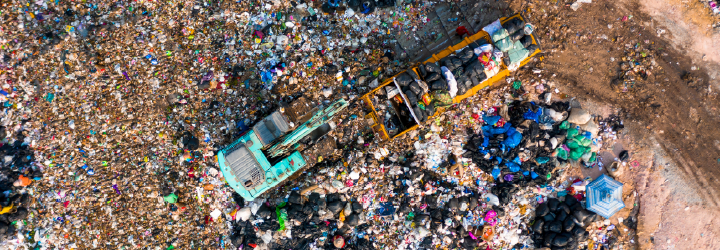
Back in 2020, an Interpol report found an alarming increase in the illegal trade of plastic pollution worldwide. In 2025, a team of journalists revealed that the problem could be far worse than ever imagined. Initially just searching for information about one young, potentially vulnerable Afghan refugee who was thought to have died working in a Turkish recycling plant, the team uncovered a much more harrowing statistic. As well as unveiling evidence of a potential cover-up by the company, the team discovered that over 200 men and boys have been killed or shredded in Turkish recycling plants in the last decade. You can listen to the three-part podcast here.
Of all the plastic waste exported by the UK, Turkey receives the most. It’s likely, therefore, that some of these entirely avoidable deaths happened when the victims were sorting through the UK’s unwanted rubbish.
For this reason alone, we all must work to reduce the volume of plastic waste we produce. It’s also important to recycle as much of it as possible here in the UK, where we have strict laws on responsible waste disposal and workplace health and safety.
So, why is the plastic problem so big, and what’s causing it?
What’s causing all of this plastic waste?
Just five companies are thought to be ‘responsible’ for almost a quarter of all global branded plastic pollution. The largest percentage originates from The Coca-Cola Company. From drinks bottles to crisp packets to yoghurt pots, food packaging is one of the worst culprits, as is smoking and vaping paraphernalia.
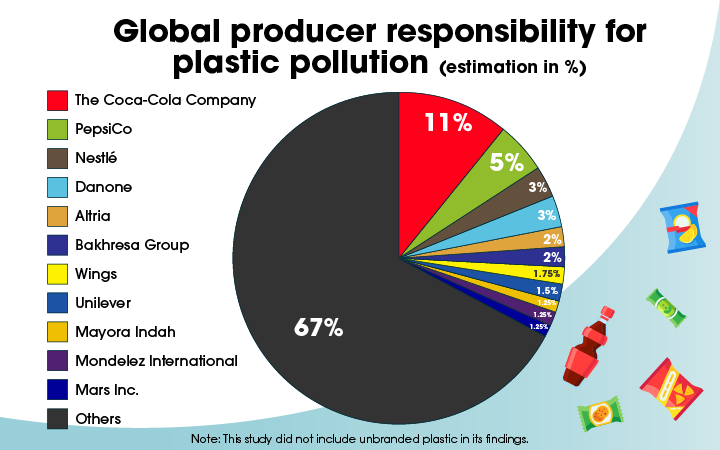
It is worth noting that there is a correlation between production volume and pollution percentage. This means that, because The Coca-Cola Group makes and sells more products, its pollution percentage is higher. If, for instance, PepsiCo produced the same quantity as The Coca-Cola Group, their pollution percentages would likely be similar.
It is also worth considering that these percentages may be higher for food and beverage companies because their products are consumed on the go, rather than at home. Products packaged in plastic that are used at home, such as shampoo bottles, are more likely to be placed into domestic bins. This, in turn, makes them less likely to escape into the environment as a pollutant, through littering, for instance.
Some brands within the producers’ groups can be found in the table below.
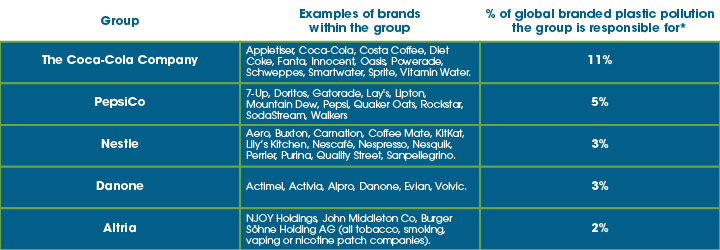
* Win Cowger et al., Global producer responsibility for plastic pollution. Sci. Adv. 10, eadj8275 (2024). DOI:10.1126/sciadv.adj8275. Available here.
It’s easy to point the metaphorical finger at brands. As consumers, however, we all need to be more responsible for the plastic we buy, use, and dispose of.
Fundamentally, the prevalence of plastic pollution can be attributed to:
- The lack of adoptable innovation in sustainable plastic industries.
While there are bioplastics made from things like corn and compostable plastic bags, the majority of these “eco plastics” aren’t disposable at home, often requiring industrial composting facilities to effectively break down. These facilities aren’t easily accessible for the average consumer, so composting isn’t really an option. Manufacturers also have to consider their own profits. If there isn’t any obligation or consumer demand to avoid single-use packaging or create more sustainable plastics, it isn’t in their financial interest.
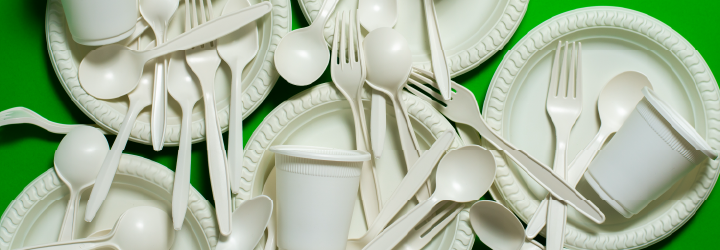
- People are not recycling enough plastic at home.
It’s estimated that less than a third of post-consumer plastic waste generated in the UK is recycled. The rest gets incinerated or ends up in landfill sites. If we all did a little bit more, more recycled plastic could enter the market, reducing the demand for new plastic.
- There is a lack of resources in many high-polluting countries to prioritise the prevention or clean-up of ocean-bound plastic.
Of the estimated 1 million metric tons of plastic waste that enters the ocean every year, the Philippines is thought to be responsible for over a third. As shown in the chart below, the majority of ocean plastic originates from lower-income countries. This indicates a lack of sufficient waste management and pollution management infrastructure. This is certainly the case in the Philippines, where there is also a heavy reliance on single-use plastics. The Philippines alone consumes 163 million sachets daily due to their affordability. These sachets make up a whopping 52% of the country’s plastic waste! When poverty is high, buying in small quantities with single-use plastic can reduce costs for low-income families. Unless funding to improve waste management in lower-income nations is raised, we will continue to see plastic entering our oceans and environments.
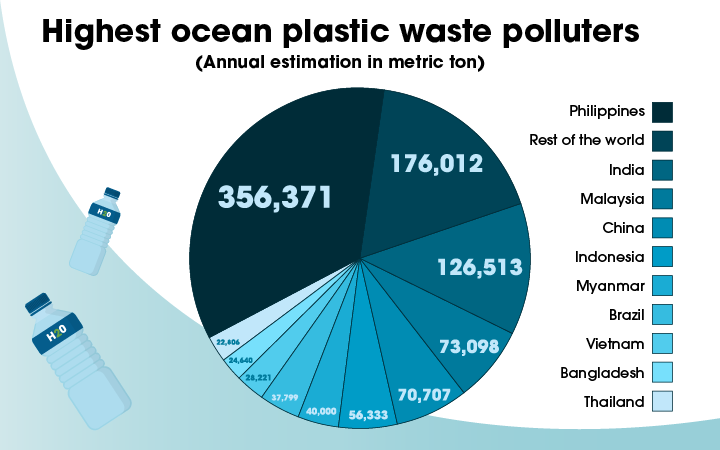
- Plastics exported abroad for recycling are being mishandled.
The UK exports a significant amount of its waste plastic abroad for recycling. However, a Greenpeace Report found that some of this plastic isn’t being recycled as planned. Plastics originating from the UK have been discovered in huge burn piles overseas in countries such as Malaysia, Turkey, and Poland. If we recycled these plastics in the UK, it could create £2bn for the economy as well as 5,000 jobs. It would also ensure the plastic is recycled and reused, and prevent unsafe practices overseas.
- There is no global treaty, at present, to improve the plastic industry and how we recycle plastic.
In the UK, measures have been made to reduce single-use plastics, including banning plastic straws, charging for single-use carrier bags, the Simpler Recycling regulations, and the upcoming roll-out of a plastic bottle and can deposit return scheme in 2027. But it’s not enough, and the world can’t agree on a plastics treaty.
What does the future of plastics look like?
Plastics are everywhere and, unless the earth’s oil runs dry entirely, they potentially always will be.
Since 2022, the United Nations Environment Programme (UNEP) has brought together the Intergovernmental Negotiating Committee (INC), hosting events worldwide to discuss the proposal for the Global Plastics Treaty. This treaty will cover issues such as restrictions on plastic production, regulating plastic consumption, imposing plastic recycling obligations, and creating safer environments for plastic recyclers, particularly in lower-income countries.
The fifth negotiation session, INC-5, which was supposed to be the final session, took place in November 2024. However, negotiators from 170+ countries failed to reach an agreement on plastic reduction measures, remaining gridlocked. INC-5.2 then took place in August 2025, but again, countries failed to agree on a Global Plastics Treaty.
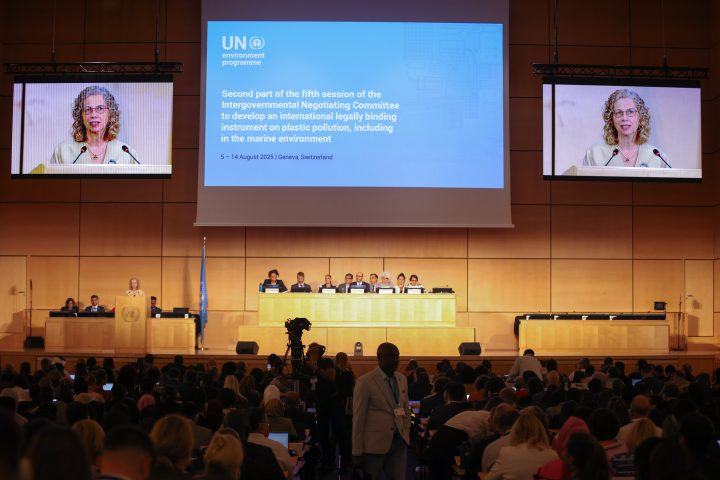
CREDIT: © Florian Fussstetter/ UNEP
António Guterres, the UN Secretary-General, said:
“I deeply regret that, despite earnest efforts, negotiations to reach an international legally binding instrument on plastic pollution, including in the marine environment, concluded without achieving a consensus”.
A coalition of oil-producing nations, such as Russia and Saudi Arabia, opposed plastic production restrictions in the treaty. Because plastic is derived from petrol, it’s no surprise that these nations would want to keep plastic production flowing as freely as possible. However, this opposition does mean that plastic production and recycling controls will, for now, remain widely unrestricted across the globe. A third conference, INC-5.3 is scheduled for February 2026.
Without a solution yet in sight, the responsible consumption of plastic and how we manage it as a waste product is more vital than ever before. Both businesses and individuals will need to use and manage plastic more sustainably – not out of obligation, but morality.
What can we do now to improve how we use and reuse plastic?
The Ellen MacArthur Foundation, an organisation that works to accelerate the transition to a circular economy, suggests the following measures to reduce plastic waste:
- Eliminate unnecessary single-use and problematic plastics.
- Innovate to ensure the plastics we make and use are reusable, recyclable, or easily compostable.
- Reuse plastics to keep them in the economy and out of the environment.
While alternatives to plastic are also recommended, it’s worth considering the potential environmental impacts, such as carbon emissions, of such options. For example, paper bags require 3x more water to make than single-use plastic bags, and release more emissions per bag. However, it’s also much easier to plant new trees than it is to remove plastic from our oceans, and paper is readily recyclable.
Another great step, if you have the luxury of living in a country with clean drinking water, is to opt for tap water over bottled water. The environmental impact of bottled water is up to 1,400 – 3,500 times greater than tap water. Making small, conscientious choices like these can help reduce unnecessary plastics.
Where plastic isn’t reusable, recycling is the best option.
Recycling plastic with Shred Station
Shred Station offers UK-wide plastic recycling services for businesses and organisations. We can recycle both soft and hard plastics, providing zero-to-landfill solutions for:
- Food and drinks packaging
- Bottles
- Crates
- Plastic products
- Packaging waste
- Dry mixed recycling, including plastics
- Bulk plastic recycling
Our bins are also now manufactured in a closed-loop process. We now granulate old or broken bins ready for remoulding into new ones.
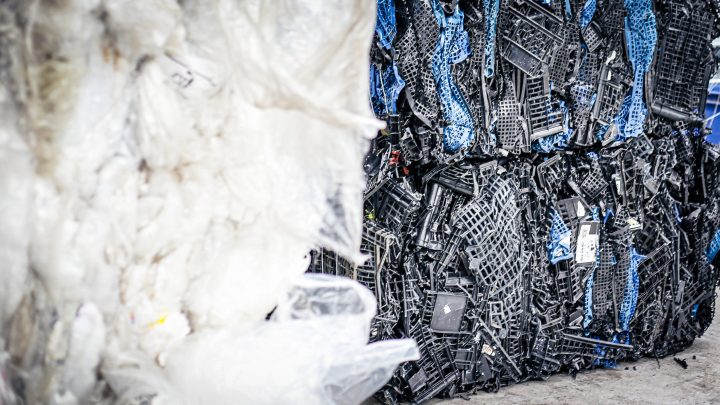
Above image: Soft and hard plastics, compressed and baled, ready for recycling at Shred Staton’s dedicated plastic recycling facility.
When we receive sorted plastics, we’ll first compress and bale them into large blocks, as shown in the image above.
For certain plastics, we can use our in-house plastic granulator to chop plastics into tiny pieces, ready to be reprocessed into new plastic. The image below shows blue plastic that we have granulated (left) and fully reprocessed plastics (right). Once of the appropriate size, these granules can be melted down for reuse in new plastic products.

As well as recycling services for plastic, we can provide secure plastic destruction services in line with EN 15713 security standards.
If your business wants to ensure your plastic is recycled responsibly, get in touch with our team for a no-obligation quote.
Until you need us, please keep reducing, reusing, and recycling your plastic at every opportunity.
